As a pen testing & security experiment and feature I want to enable write protect on my SPI Flash MX25L8005 module on my motherboard to protect the SMM modules, AML, ACPI and other areas of the BIOS that could potentially be overwritten or modified by malware.
Page 11 of the Datasheet
"The Status Register Write Disable (SRWD) bit, non-volatile bit, is operated together with Write Protection (WP#) pin for providing hardware protection mode. The hardware protection mode requires SRWD sets to 1 and WP# pin signal is low stage. In the hardware protection mode, the Write Status Register (WRSR) instruction is no longer accepted for execution and the SRWD bit and Block Protect bits (BP2, BP1, BP0) are read only."
"A lot of SPI flash chips have a pin that, when connected to ground, disables writing. You'd have to read the datasheet for the flash chip you have. Locate the chip and read the text on it (which tells you the model), then look up its datasheet."
You probably wouldn't want to set SRWD. You'd only want to use WP#.
Do note that even with a read-only BIOS, PCI option ROMs can still be written. I imagine the BIOS configuration, including the disabling of option ROMs, is not protected by WP#, in which case a malicious privileged process could modify an option ROM, change BIOS configuration, and then the BIOS would call the malicious ROM at next boot. Note that TPM-based SRTM defeats that attack.
I was told that I might need to use a pull-down resistor if one isn't built in internally, otherwise I can cause a short, and that relevant data should be in the datasheet. I am asking anyone in the know, with total confidence, to tell me what I need to do in order to accomplish write protections without damaging my hardware.
This will ensure protection against all forms of zero day malware that could modify, embed and remain persistent in flash devices, evading even the most sophisticated security protections. The simplicity and effectiveness of this is tried and tested.
